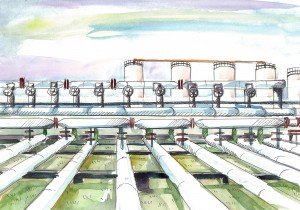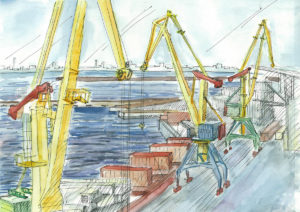
Exoskeletons in Construction in the Republic of Kazakhstan.
Background information on Exoskeletons
An exoskeleton is a device designed to replenish lost functions, to increase the strength of human muscles and to expand the amplitude of movements due to the external frame and leading parts.
It repeats the human biomechanics for a proportional increase in efforts during movements.
Areas of use of exoskeletons in construction:
- Carrying out loading and unloading operations using an exoskeleton of the lower and upper extremities. A typical scenario of application is carrying the cargo over short distances;
- Maintaining massive structural elements in the course of their installation, or fixing parts during assembly of units;
- Assembling of metal structures, frameworks of houses, bearing elements, log structures, and their installation on the foundation;
- Pipe laying and construction of pipelines and other underground utilities;
- Digging trenches where there is heavy ground or where it is impossible to use special construction equipment or machinery;
- Construction of railway lines and cable networks, especially in confined spaces where heavy construction equipment cannot work (e.g., mines, bunkers, and other underground constructions);
- Using an exoskeleton of lower and upper extremities in the work on a manual vibrating tool (such as a jackhammer, a tamping machine, and road-building vibrating plates) is able to prevent the development of vibratory disease;
- Installation and dismantling of construction equipment;
- Installation and dismantling of panel formwork and formwork systems; and
- Road construction and work of public utilities.
Limitations in Legislation of the Republic of Kazakhstan On Using Exoskeletons in Construction
First of all, it is necessary to determine under what term or definition exoskeletons fall pursuant to existing legislation of the Republic of Kazakhstan.
Pursuant to legislation of the Republic of Kazakhstan, exoskeletons can be attributed to:
- Special clothing. Pursuant to clause 3.3 of the Sanitary Standards of the Republic of Kazakhstan, No. 1.03-05-2011, the special clothing includes clothing, shoes, headgear, mittens, and other items intended to protect a worker from harmful and / or dangerous production factors.
- Production equipment. Pursuant to clause 3.24 of the Sanitary Standards of the Republic of Kazakhstan, No. 1.03-05-2011, the production equipment includes machines, mechanisms, devices, facilities, apparatus, tools, and other technical means that are necessary for the work or production.
- Pursuant to the Construction Rule of the Republic of Kazakhstan, No. 1.01-101-2014, the devices are a set of elements representing a single design (a multi-contact relay, a set of transistors, a board, a block, a cabinet, a mechanism, a dividing panel, etc.). A device can have no specific functionality in a product.
Based on the above definitions contained in the existing construction standards and rules, it can be concluded that exoskeletons fall more or less under the concept of “production equipment” or “device”.
Current legislation of the Republic of Kazakhstan, due to appropriate circumstances, cannot regulate all new technologies increasing appearing in the market every time, however there are provisions that establish general requirements for machines, equipment and mechanisms used in construction.
For instance, pursuant to sub-clause 5.2.2 of the Sanitary Standard of the Republic of Kazakhstan, No.1.03-05-2011, production equipment, devices and tools used to organize a workspace must meet the occupational safety requirements and the Sanitary Rules and Standards No. 1.01.002-94.
Additionally, in accordance with clause 6.6 of the Sanitary Standard of the Republic of Kazakhstan, No. 1.03-05-2011, it is necessary to ensure the high quality of used materials, products, structures and construction machines, and mechanisms certified by the authorized bodies in terms of their explosion, fire safety and toxicity. Effective sound or light alarm must be ensured. Inventory tools and mounting devices and tooling used in construction must meet all fire safety requirements.
Thus, legislation of the Republic of Kazakhstan establishes a limitation on the use of exoskeletons which consists in the mandatory certification thereof.
The certification is carried out in accordance with the Law of the Republic of Kazakhstan “On Technical Regulation”, which defines mandatory certification as a procedure for confirming product compliance with the requirements established by the technical regulations, with the involvement of conformity assessment bodies (paragraph 16, Article 1).
As part of certification, products are examined for their compliance with the requirements of the technical regulations and rules established in Kazakhstan. Pursuant to paragraph 1 of Article 18 of the Law of the Republic of Kazakhstan “On Technical Regulation”, technical regulations, subject to the degree of risk of causing harm, establish the minimum necessary requirements ensuring the safety of products and processes.
Thus, the certification confirms the safety of product use. It is logical to assume that if an exoskeleton was certified, then there is no restriction to use it.
The certification in Kazakhstan is carried out in accordance with the RoK ST standard 3.4-9.4 “State Certification System in the Republic of Kazakhstan. Product Certification Procedure. General Requirements".
Pursuant to clause 4.1 of the above standard, the product certification stages are as follows:
- submission by the applicant of an application to the certification body;
- sending to the applicant a decision on the results of consideration of the application;
- formalizing a product certification contract between the applicant and the certification body;
- selection and identification of samples of products indicated in the application and the provision of such samples to the testing laboratory (center);
- certification testing of samples of products indicated in the application and other works under the certification scheme;
- analysis of the results obtained and making a decision regarding the possibility to issue a certificate of conformity;
- issuance of a certificate and its registration with the State Register of the State Standardization System of the Republic of Kazakhstan;
- labeling certified products with the mark of conformity;
- conducting an inspection control over the stability of certified product characteristics and the functioning of the quality assurance system (if so provided for by the certification scheme); and
- provision of information on the results of product certification.
As mentioned above, the certification is a confirmation of compliance of equipment with the requirements of technical regulations.
In accordance with paragraph 45 of Article 1 of the Law of the Republic of Kazakhstan “On Technical Regulation”, technical regulation is a regulatory legal act establishing mandatory requirements for products and / or processes of their life cycle, developed and applied in accordance with legislation of the Republic of Kazakhstan in the field of technical regulation.
In Kazakhstan, there is no existing technical regulation regarding devices, such as exoskeletons. In the international practice, such devices are certified for compliance with the requirements of ISO 13482-2014 “Robots and Robotic Devices. Safety Requirements for Robots for Personal Care.”
Pursuant to clause 3.1 of the RoK ST standard 3.4-9.4 “State Certification System in the Republic of Kazakhstan. Product Certification Procedure. General Requirements", in the absence in Kazakhstan of regulatory documents establishing the requirements for applied or similar products, tests must be carried out for compliance with the regulatory documents of the country (company) of the importer, represented by the applicant.
Thus, in the absence of technical regulations, the applicant must submit a regulatory document of the import country in order to determine compliance of the equipment with the established standards.
Liability for Use of Non-Certified Equipment
Administrative Liability
Liability in the area of certification is established for the following actions:
1) production and sale of products that do not meet the requirements of technical regulations;
2) release for the wholesale or retail trade or to the markets of products not meeting the requirements of the regulatory document on standardization;
3) import and / or sale of products that are subject to mandatory confirmation of conformity, without a certificate of conformity, a mark of conformity, or a declaration of conformity, as well as in the event of falsification thereof or expiration or suspension of the validity period thereof;
4) violation of the procedure for the work on conformity assessment and accreditation;
5) unreasonable issue or confirmation of the validity of a certificate of conformity as well as unreasonable acceptance or registration of a declaration of conformity or a declaration (part 1 of Article 415 of the Administrative Code of the Republic of Kazakhstan).
There is no separate set of elements of an offense that provides for a liability for using non-certified equipment.
However, the use of non-certified equipment might entail the liability under part 1 of Article 312 of the Administrative Code of the Republic of Kazakhstan, which is as follows:
The performance of pre-design, survey, design, construction and installation works, the production and use of building materials, parts and structures in violation of the requirements of legislation of the Republic of Kazakhstan in the field of architectural, town planning and construction activities shall
entail a penalty on officials in the amount of sixty, on small businesses - in the amount of two hundred, on medium-sized businesses - in the amount of four hundred, and on large businesses - in the amount of seven hundred, times the monthly calculation index.
The above set of elements of an offense is, as we see, quite general and can include anything. As noted above, pursuant to the existing Sanitary Standard of the Republic of Kazakhstan, No. 1.03-05-2011, the equipment used in construction must be certified. Thus, the use of non-certified equipment results in a violation of the legislative requirements in the field of architectural, town planning and construction activities and, accordingly, the liability under part 1 of Article 312 of the Administrative Code of the Republic of Kazakhstan occurs.
Criminal Liability
As in respect of administrative liability, the Criminal Code of the Republic of Kazakhstan contains no separate set of elements of a crime for the use of non-certified equipment. However, there is a general article for violations in the field of architectural, town planning and construction activities.
Article 279. Violation of Rules or Requirements in the Field of Architectural, Town Planning and Construction Activities
- Violation of the rules or requirements of standards in the field of architectural, town planning and construction activities, resulting either in the death of an individual by negligence or in other serious consequences, shall be punished by the imprisonment for a term of up to six years, with or without deprivation of the right to hold certain posts or to perform certain activities for a term of up to three years.
- The act envisaged in part one of this Article, entailing the death of two or more individuals by negligence,
shall be punished by the imprisonment for a term from three up to eight years, with or without the deprivation of the right to hold certain posts or to perform certain activities for a term of up to three years.
Prepared in August 2018
Victoriya Chagay, Lawyer
Andrey Artyushenko, Managing Partner







